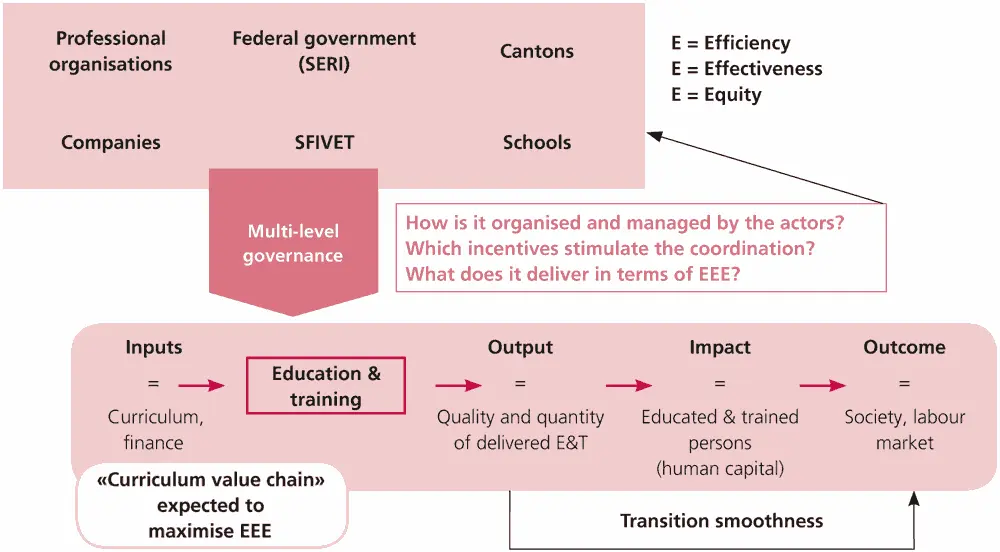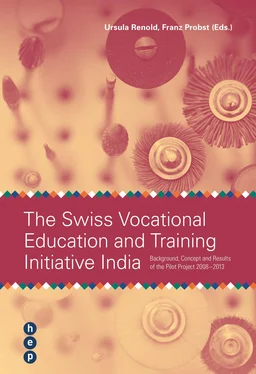
Figure 4: Governance of the Swiss vocational education and training system. Compiled by the authors
When taking a closer look at the three actors involved, the following comes to light. The main task of the federation is the development and adaptation of the VPET legislation and the strategic development of the entire system. The cantons are responsible for the implementation of the VPETA and the provision and supervision of the vocational schools. Switzerland comprises 26 cantons, and there are therefore 26 cantonal VET offices which are entrusted with the implementation and supervision of VET. To facilitate the coordination between the VET offices, the Swiss VET Offices Conference (SBBK) was set up. Other tasks of the VET offices involve the inspection of training companies, provision of job information centres, marketing of VET as a good study option and the supervision of the regional apprenticeship market.
| Level |
Professional organisation |
Unions |
Role in VPET governance |
| Role in VPET governance |
Swiss Employers Confederation |
Confederation of Swiss Trade Associations |
Swiss Federation of Trade Unions |
TravailSuisse (Swiss Associations of Commercial Employees) |
Member of Federal Commissions / Federal expert groups, policy topics |
| National |
Professional organisations |
Professional organisations |
Trade unions: involvement only based on «collective labour agreements» |
Responsible for occupation, framework curriculum, training material etc. |
| Regional |
Regional chambers of commerce of trade associations |
Regional sections of trade unions |
Promotion of apprenticeships, exam experts |
Figure 5: Social partner organisations in Swiss VET. Compiled by the authors
The third partner, the professional organisations, are either employers’ or employees’ organisations. Employers’ organisations are composed of professional associations, companies and smaller VET organisations. Social partnerships in Switzerland generally function very well, and the unions, although not as strong as in Germany, have an impact on VET by influencing education policy. Figure 5 lists the different responsibilities of the most important social partners.
The members of professional organisations are jointly responsible for the training plan content and decide together with the federal government which VET programmes are needed. This decision-making power over the training plans ensures that the professional organisations in particular play a major role in determining the content of education curricula. The drafting of training plans is of great importance, since the professional organisations use them to determine which professions are demanded on the labour market and should therefore be included, updated or excluded. In addition, the professional organisations are responsible for providing apprenticeship positions, the provision and running of inter-company courses, the production of teaching material for the training establishments and the implementation of practical tests. Another task involves revising the job-specific VET ordinances.
The job-specific VET ordinances are laws which contain the basic education plans of each occupation. Education plans can be understood as national core curricula which are concretised in the respective places of learning through school curricula, in-house training programmes or inter-company course programmes. We will therefore be discussing the framework curricula below. These framework curricula, that have existed for all occupations only since the newest VPETA came into force, are the centrepiece of the Swiss VET system. In hardly any other country is the content of the qualification standards for all places of learning managed in such a coordinated and transparent way. The ordinances, which are listed in the Classified Compilation of Federal Law, govern for example the occupation, training content, criteria that must be met to be counted as a qualified employee and the qualification process, i.e. national or local assessment and verification.
There are around 230 occupation-specific ordinances that have been promulgated by the State Secretariat for Education, Research and Innovation (SERI), formerly known as the Federal Office for Professional Education and Technology (OPET). SERI ensures that the regulations are applicable throughout Switzerland, i.e. for large and small businesses. At professional education and training level, SERI recognises eight areas[9] with 57 subjects and 450 education programmes at PET schools (SBFI 2015b) and around 400 national PET examinations[10].
The federal government, the cantons and the professional organisations together adapt the ordinances, with the professional organisations and the social partners again taking the lead. To avoid having to readjust the process each time, the federal government has developed guidelines that adhere to the necessary steps. An important guideline for VET is the manual for the creation and updating of VET ordinances. It describes in detail each step in the renewal process and defines the responsible actors (BBT 2007). Hence, knowledge about VET planning is documented and the curricula enjoy a comparable qualification standard.
Other actors in addition to the three main partners include, for example, the Swiss Federal Institute of Vocational Education and Training (SFIVET) and researchers. SFIVET is a tertiary-level university institute for prospective VPET teachers and students who wish to specialise in VPET. For those who are interested in VPET system management in Switzerland, SFIVET offers a Master of Science in Vocational Education and Training. This institute is the first choice for teacher training in the field of VET, and also offers training courses for experts in PET (mostly prospective teachers in VET, examination experts or teachers for inter-company courses).
Besides SFIVET, other institutes may also offer training in the field of VPET. They require approval from the federal government as well. The requirements for prospective VET teaching staff are very demanding due to the high standards which need to be fulfilled. Vocational school teachers in upper-secondary II education, for example, require a university degree, at least six months’ experience and 1,800 hours’ experience in VET pedagogy. The minimum requirements are laid down by law and concretised in the framework curricula for the VET authorities (SBFI 2015c).
Other actors are researchers who influence the design of the VPET system with the results they provide. The research results demonstrate why the Swiss VPET system has been so successful, and point out potential for improvement[11] to ensure the optimisation of its efficiency, effectiveness and equity (see SKBF 2010, SKBF 2014).
To ensure the quality of the VPET system at national level, the partners have developed specific guidelines. Job-specific VET ordinances are therefore binding for all VPET institutions, regardless of whether these are private or public institutions. Academic titles and degrees are not awarded at the discretion of the offering institution but have to meet a number of standards in order to gain recognition by the federal government. The advantage here is that the degrees offered by different schools for the same occupation are comparable throughout Switzerland. This in turn helps companies during the recruitment process, as they can rely on the stated abilities of the graduates or candidates. This is a big advantage compared to colleges or schools, where the focus is on autonomy in curricula design, but their curricula are not equivalent throughout Switzerland. The occupation-specific ordinances therefore ensure the graduates’ mobility within the Swiss labour market.
Читать дальше













